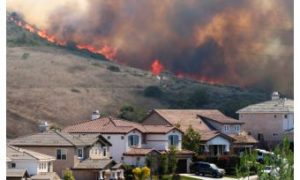CoreLogic®, a leading global property information, analytics and data-enabled solutions provider, recently announced the launch of its new publicly-accessible risk information resource center, Hazard HQ(tm). This new information hub will offer individuals, media and companies high-level analyses and up-to-date data insights on the immediate risks natural catastrophes pose to properties across the country.
The latest risk summary for Hazard HQ focuses on the ongoing California wildfires. As comprehensive risk assessment needs increase alongside growing economic losses from natural catastrophes, Hazard HQ offers a high-level risk perspective for individuals and companies who wish to understand how hazards like earthquakes, floods, hurricanes, severe convective storms, wildfires, wind and volcanic activity can impact their regions.
Senior leader of content and strategy for CoreLogic, Maiclaire Bolton Smith, spoke with GISCafe Voice about the new resource center and how it is dedicated to offering catastrophe insights about events while they are happening.
Does Hazard HQ take in citizen information?
No, it focuses on information from CoreLogic. Corelogic can provide insight and information, whether wildfire, hurricane, earthquake or flooding, and offers insights on number of properties that could be at risk, or on an area that could be impacted and the home value that could be lost. No information is pulled from citizens. It’s our opportunity to share information with others to help them protect themselves and be able to restore from financial catastrophe.
It really evolved as a way for us to share information easily.
We’ve had all these devastating wildfires this summer already. We always try to learn from the events that have happened. We’ll always be providing more information on research. For example, with regard to the wildfire that happened in Sonoma County, California last year that impacted Santa Rosa, over the past six months we’ve done a lot of research looking at the reconstruction from that wildfire and the state of the homes being rebuilt and looking at some of the insurance impacts and implications from that event happening. An event doesn’t end when an event ends, it’s a long process afterwards to really recover from it, so we will continue to share more information on an ongoing basis as we continue to research events.
How do you expect risk analysis you’ve done last year is going to impact or help in the assessment of the damage of the Mendocino fire, as an example, right now?
The biggest factor is that it brings awareness to the impact that these devastating events do have. We hear about the hundreds of thousands of acres burned, but a lot of times the fires are burning in remote areas and there are not a lot of properties at risk. It’s devastating to see the area burned, but what we want to focus on is bringing awareness to insurers and other people about where there are homes and properties at risk, and focus on the human aspects of it. What people can take away from our previous research, is
- Being prepared for hazards that could happen, whether it be a flood, earthquake, hurricane, etc. We’re prone to disasters all the time in various parts of the country.
- Awareness of the events that can happen, and our main goal is to work with insurance companies and help them understand what properties are valued at to be able to insure properties properly.
- The general public needs to know they need insurance for a lot of these hazards. Insurance can really help them recover from events when they do happen. Hopefully they won’t be impacted but if they are, to know their risk and to be able to accelerate their recovery is a huge bonus.
Say a customer is obtaining insurance for things they expect but what about these events that happen way beyond anyone’s expectations?
Unfortunately, those rare events are the wild card that are really beyond planning scenarios. I’m actually a seismologist by training and I spend a lot of time training people to know their earthquake risk. I always say the number one thing people can do to prepare for an earthquake, is believe that it can happen, and that’s the same with all disasters. The possibility is there that it may occur. These are hard for people to conceptualize and plan for.
At CoreLogic we do risk modeling where we look at the range of events that can happen – the more common events to the very extreme events. That’s the information we provide to insurance companies, including what could the worst-case scenario even look like.
I have spoken to CoreLogic many times. In the past the company has said with the fires we’re expecting an increase in losses to homes because people have built closer to forests, and forests are not cleared as often, we run the higher risk.








